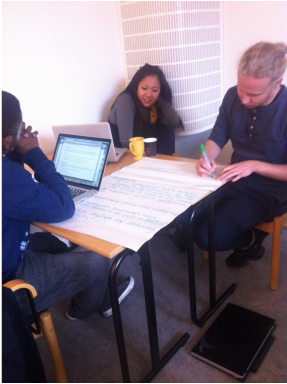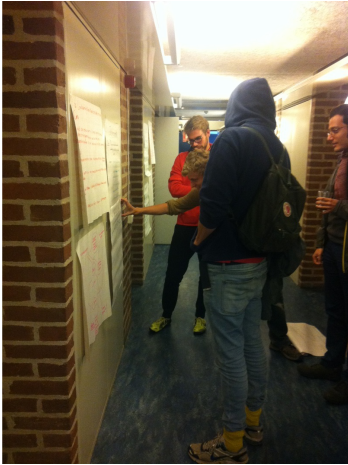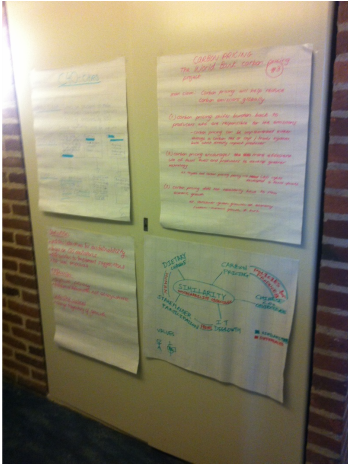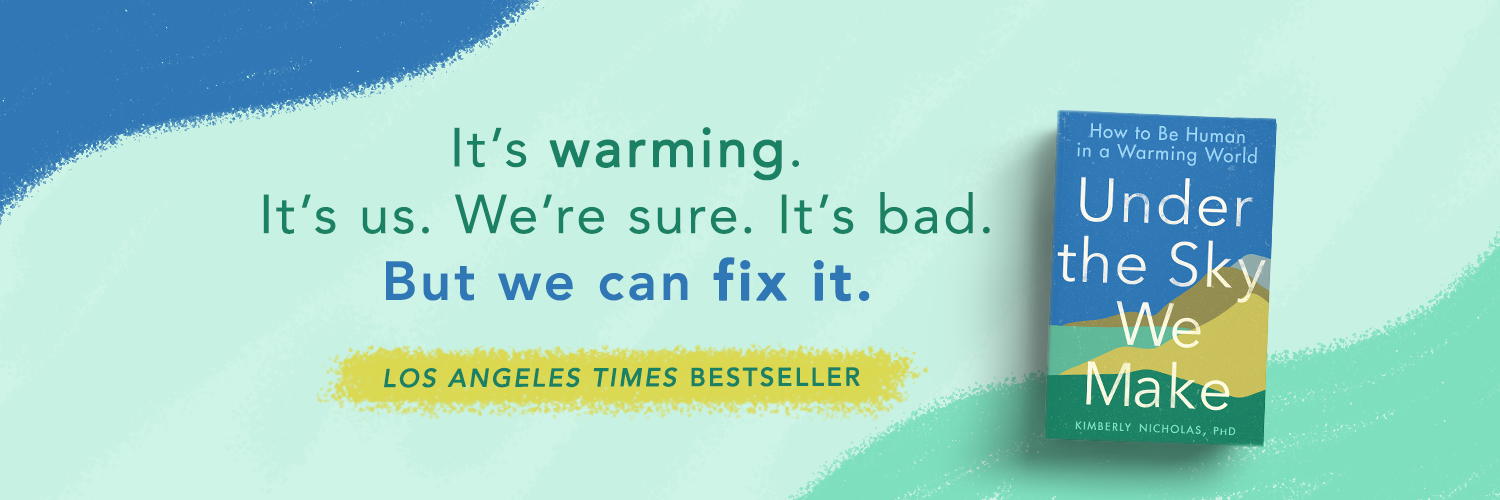Climate Change "We Can Fix It World Café" 2018
Welcome to the World Café!
Inspired by student feedback, this is a 3 hour activity where students analyze, compare, and present climate solutions proposed and now underway from governments, non-governmental organizations, businesses, scientists, citizens, and more.
The "World Café" method is a facilitation technique for large group dialogue, introduced to LUMES by students from Batch 14 who participated in the Art of Hosting workshop. (Sorry, it doesn't mean treats and coffee, though you're welcome to bring some to share!)
The goals is to inform and empower as well as gain a critical perspective on climate change action. You can read more about the motivation for this activity here, or dive right in below with preparation, instructions for running the World Cafe, and a reading list.
Student or teacher feedback on the activity, or suggestions for additional solution resources, are welcome to @KA_Nicholas on Twitter.
Past climate solutions archives with different reading assignments: 2014, 2015, 2016, 2017.
Inspired by student feedback, this is a 3 hour activity where students analyze, compare, and present climate solutions proposed and now underway from governments, non-governmental organizations, businesses, scientists, citizens, and more.
The "World Café" method is a facilitation technique for large group dialogue, introduced to LUMES by students from Batch 14 who participated in the Art of Hosting workshop. (Sorry, it doesn't mean treats and coffee, though you're welcome to bring some to share!)
The goals is to inform and empower as well as gain a critical perspective on climate change action. You can read more about the motivation for this activity here, or dive right in below with preparation, instructions for running the World Cafe, and a reading list.
Student or teacher feedback on the activity, or suggestions for additional solution resources, are welcome to @KA_Nicholas on Twitter.
Past climate solutions archives with different reading assignments: 2014, 2015, 2016, 2017.
Student Preparation
Before class, please read/watch/listen to/engage with:
Please bring a copy of the material you read (hard copy or electronic) to class with you reference during your discussion.
- The motivation for this activity here.
- Your material (called "report" for simplicity below) for your assigned group. You're encouraged to browse around and investigate more about this solution if you like.
- The full instructions for the in-class activity below.
Please bring a copy of the material you read (hard copy or electronic) to class with you reference during your discussion.
Reading List
Teacher Preparation
- This activity is designed for a three-hour seminar (possible to modify for two hours by doing only parts 1 and 2 below, and skipping the poster session). I designed it for the LUMES master's program, but it should work for other levels of students as well.
- Select as many reports as needed so that there will be four students discussing each report (I used all 12 reports below for my class of 46 students, with 10 groups of 4 students and 2 groups of 3 students; with 3 students, combine timekeeper & facilitator roles).
- Assign students (or have them sign up) to read one of the recent reports below, which offer different proposals for addressing climate change.
- Materials: Post-it with table number (1-12) to later hang on the wall; flipchart paper; markers; tape to hang posters.
- Arrange classroom tables to seat groups of four, and give each table a Post-it with a number corresponding to the report students will read (#1-12). Each table will need a large piece of paper (flipchart or butcher paper) and markers for drawing their posters.
- Give students the instructions below ahead of time, and start class with a brief overview as reminder.
- During the World Café, circulate and answer questions.
- Announce when there are 10 minutes left to make sure all students complete their poster.
- Provide tape or thumbtacks for students to hang posters in a corridor or classroom where they can all circulate for the poster session.
- During the first break, provide fresh paper for each table to make a new poster in the second session.
- During the poster session, remind students the order of poster presentation (10 minutes each for the Synthesizer, Facilitator, Timekeeper, and Visualizer to present their poster from Part 1, while the other 3 group members circulate and learn about other posters.) Announce when it's time for students to switch roles every 10 minutes, so all get a chance to present and to circulate.
Part 1: One Solution (45 minutes)
|
- (Put the answers to each question on your poster, along with the report name and your group members' names):
Start by assigning each member of the group one of four roles:
- Facilitator- start and keep the conversation moving, ask questions, make sure all have an equal chance to contribute.
- Visualizer - take the lead in capturing the key ideas you discuss in words and drawings on your poster.
- Timekeeper - keep an eye on the clock, redirect conversation if it is getting off topic, move ahead to address all the discussion points.
- Synthesizer - keep an eye on the big picture, and offer a summary of the group's conclusions for each question to help the Visualizer make the poster as you go along.
Discussion questions- Part 1:
(Put the answers to each question on your poster, along with the report name and your group members' names):
- What is the main claim of the report? What reasons and evidence are given to support the claim?
You may wish to use the worksheet based on the paper by Ladaea Rylander of Lund University Academic Support Centre to help you diagram and discuss them. Remember that a claim is the central argument or thesis statement (which could be true or false); reasons articulate the logic of a claim and give relevant answers for the question of why a claim might be true; and evidence provides examples and data that prove the correctness of the reasons. - Discuss the proposed plan in terms of its effects the elements of the Kaya Identity explaining the drivers of CO2 emissions:
Remember that the four terms driving environmental impact are:
Population (number of people, or "capita" to make the units cancel out)
Wealth (GDP/capita)
Energy Intensity of GDP (Energy consumption/GDP)
Carbon intensity of energy (CO2/energy consumption)
- Consider the author of the source. How does this influence your evaluation of the proposed plan? (For example, what kind of organization do they work for, and how do you think this influences their perspective?)
- Now you've discussed the "They Say" piece that begins any critical academic conversation (Graff and Birkenstein, 2010, They Say/I Say: The Moves That Matter in Academic Writing). What do "you say"- what is your response to the report? What are its strengths and weaknesses? If you were a science advisor to policymakers, would you support the proposal?
Part 2: Many Solutions (45 minutes)
|
- Start by assigning new roles to each person.
- Each student should briefly summarize the key points of your report to this new group (aim for 3 minutes each). You may want to refer to your notes, and show any key figures from the report that help you make your point.
- Discuss the questions below and make a second poster that answers them. Be sure to put your names on the poster, and list which four proposals you were discussing.
- During the break, please hang your second poster on the lower panels in the corridor.
- Based on your role in the first discussion group, you'll take turns presenting your poster to other students.
Discussion questions- Part 2:
(Put the answers to each question on your poster, along with the report names and your group members' names):
- What are the similarities and differences between the proposals? What areas of synergy or conflict do you see between the different proposals?
- What underlying values does each proposal represent? (Consider, for example, arguments promoting equity, development, growth, etc.)
- Does your group agree on a strategy that seems the most promising out of the ones you've discussed? Why or why not?
Part 3: Poster Session (45 minutes)
First 10 minutes: The Synthesizer from Part 1 presents their poster, while the other 3 group members circulate and learn about other posters. Second 10 minutes: The Facilitator from Part 1 presents their poster. Third 10 minutes: The Timekeeper from Part 1 presents their poster. Fourth 10 minutes: The Visualizer from Part 1 presents their poster. |





